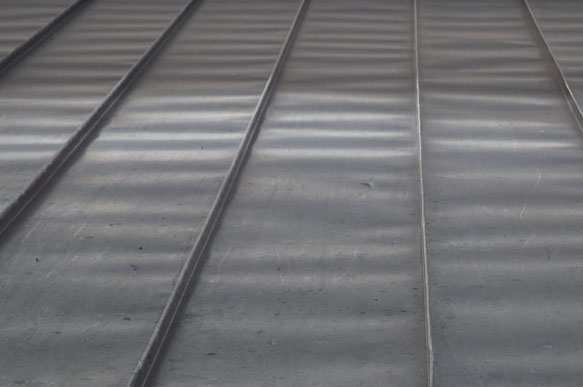Oil Canning
Oil canning is a characteristic of thin gauge cold formed metal products defined as moderate deformation or buckling of sheet material, particularly common with flat sheet metal surfaces. Typically caused by uneven stresses at the fastening points. This terminology also refers to the popping sound made when pressure is applied to the deformed sheet forcing the deformation in the opposite direction.* Internal stresses within the metal can cause a waviness in the surface of the profile. There are many ways that the effects of oil canning can be minimised however due to the inherent nature of metal it can not necessarily be removed completely.
Some of the common causes of oil canning are;
Profile dimensions
The thinner the gauge of metal used and the wider the flat pan section of the profile the more evident oil canning will be. Inclusion of ribs or embossments will assist in reduce oil canning.
Manufacturing
The very nature of the manufacturing process of the profile can lead to oil canning. Any additional stresses put in the metal by way of shaping the metal or by slitting the coil can cause oil canning.
Substructure
Any unevenness in the supporting substructure or any movement in the substructure will increase the effects of oil canning.
Connection detailing
Taking care with the connection details of the profile will assist in the effects of the oil canning. By allowing for expansion and contraction of the material the effects of oil canning will be minimised. This can be done by utilising by slotted holes and thermal breaks. It is important that if you are not familiar with detailing products that are prone to oil canning that you discuss with your local Fielders® representative ways to minimise the effects.
Material finish
The colour and finish of the material chosen will also effect the oil canning in the profile. Profiles of a dark colour make oil canning more obvious to the eye, as well as increasing the solar absorption of the material the thermal expansion and contraction of the material will also increase. The surface finish, i.e. a gloss or matt finish, will also affect the appearance of the oil canning. The higher the gloss finish the more the obvious the oil canning will be to the eye.
Weather
The weather plays a major role in the appearance of oil canning. The change in temperature on the surface of the profile will impact on the thermal expansion of the profile. Even though there may not a large temperature difference in the ambient temperature there can be significant differences in temperature on the surface of the metal. A profile may be subjected to early morning frost, but by being positioned in full sun the surface temperatures can easily reach over 50°C during the day. There are many factors that can adjust the temperature experienced by the profile from the colour of the profile to location, orientation and shielding.
Light
Light will impact on how noticeable oil canning is. Some days and times of day the oil canning may be more noticeable than others. The orientation that the light is reflecting off the waviness of the oil canning effects the way it is perceived by the eye.
Handling & storage
Due care needs to be taken with all profiles especially those with large flat pans. Any additional stress put on the material will increase the likeness of oil canning appearing in the pans.
Oil canning is generally an aesthetic issue and structural integrity is typically not affected. In the absence of specific contract requirements oil canning should not be the sole grounds for panel rejection.
Note:
Definition of oil canning adopted from SA HB39 2015.
